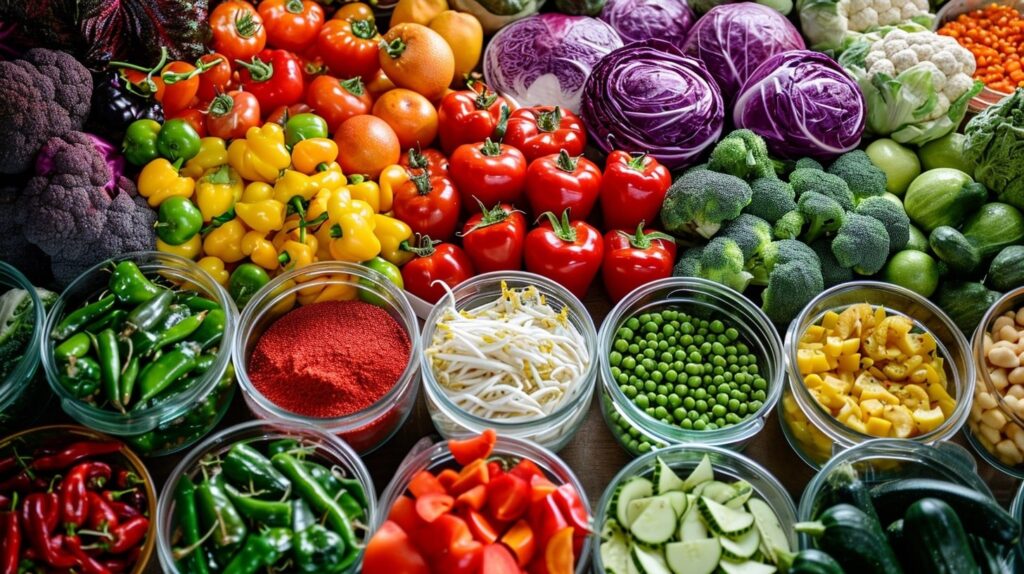Incorporating a diverse range of fruits and vegetables into your daily diet is more than a colorful addition to your plate—it’s a fundamental step towards a healthier life. These natural powerhouses are loaded with essential nutrients and fiber, playing a vital role in maintaining your well-being. As we delve into the nutritional benefits, the importance of variety, and the smart selection of produce, remember that even small dietary changes can have significant impacts. For those seeking to manage their health better, resources like the ‘My Heartlet’ app offer valuable guidance on maintaining a heart-healthy lifestyle.
Table of Contents
The Nutritional Power of Produce
Fruits and vegetables are the cornerstones of a nutritious diet. Each serving is packed with vitamins, minerals, and dietary fiber, which are crucial for optimal body function. For instance, leafy greens such as spinach and kale are rich in iron and vitamin K, while citrus fruits like oranges provide a hefty dose of vitamin C, as outlined by Harvard School of Public Health. The fiber found in produce not only aids digestion but also helps in controlling blood sugar levels, contributing to a decreased risk of type 2 diabetes.
A diet abundant in fruits and vegetables has been consistently linked to a lower incidence of chronic diseases. The antioxidants in berries, for instance, can combat oxidative stress, while the potassium found in bananas is known to maintain healthy blood pressure levels. Moreover, the consumption of plant-based foods is associated with better cholesterol profiles, which directly translates to a reduced risk of heart disease.
Additionally, fruits and vegetables are naturally low in calories, making them an excellent choice for weight management. By replacing higher-calorie foods with these nutrient-dense options, individuals can enjoy more substantial portions while still adhering to a calorie-controlled diet, thereby supporting a healthy weight without feeling deprived.
Opt for a Colorful Plate
The phrase “eat the rainbow” isn’t just a catchy saying—it’s sound dietary advice. The color of fruits and vegetables is indicative of the nutrients they contain. For example, red produce like tomatoes and red peppers are known for their lycopene content, a powerful antioxidant. Similarly, the deep hues of blueberries and blackberries come from anthocyanins, which have been linked to brain health.
To ensure a wide range of nutrients, aim to include a variety of colors in your diet. Here’s a quick guide to get you started:
- Red: Apples, strawberries, beets
- Orange/Yellow: Carrots, oranges, sweet potatoes
- Green: Broccoli, avocados, kiwis
- Blue/Purple: Eggplants, grapes, plums
- White/Brown: Garlic, onions, mushrooms
Each hue represents a different set of phytochemicals and nutrients, emphasizing the importance of diversity in your fruit and vegetable intake. Regularly incorporating a spectrum of colors into your meals not only enhances the visual appeal but also maximizes your body’s intake of various vitamins and minerals.
Choosing the Best Fruits and Vegetables Options
When selecting fruits and vegetables, it’s vital to consider the form they come in—fresh, frozen, or canned. Fresh produce is often touted as the best choice, but frozen options can be equally nutritious. In fact, frozen fruits and vegetables are typically picked at peak ripeness and immediately frozen, preserving their nutritional value.
Canned varieties, on the other hand, are convenient and have a longer shelf life. However, it’s important to read labels carefully to avoid added sugars in fruits and excess sodium in vegetables. Look for products labeled “no added sugar” or “low sodium” to make healthier choices. And remember, rinsing canned vegetables can reduce sodium content significantly.
Here are some tips for incorporating more fruits and vegetables into your diet:
- Add berries or sliced banana to your morning cereal or yogurt.
- Include a vegetable side with every meal, such as a salad or steamed broccoli.
- Use vegetable-based sauces like tomato or pumpkin to increase your intake.
- Snack on raw veggies like carrots or bell pepper strips with hummus.
By keeping these points in mind, you can make informed decisions that contribute to a more nutritious, balanced diet.
The journey towards a healthier lifestyle is paved with the vibrant colors of fruits and vegetables. By understanding the nutritional power of produce, embracing a palette of colors on your plate, and choosing the best options available, you’re well on your way to reducing the risk of heart disease and maintaining overall health. For additional support and personalized health tracking, consider utilizing tools like the ‘My Heartlet‘ app to keep your heart health in check. Remember, every bite of nutrient-rich fruits and vegetables is a step in the right direction for your wellbeing.
